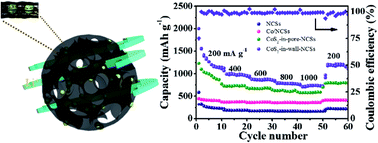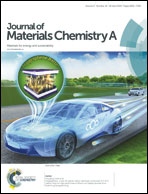CoS2 nanodots trapped within graphitic structured N-doped carbon spheres with efficient performances for lithium storage†
Abstract
Cobalt sulfide (CoS2)-based nanomaterials are promising electrode materials for various energy storage and conversion applications due to their large specific capacities and catalytic activities. However, CoS2-based nanomaterials are still suffering from their volume expansion, agglomeration and poor cycling stability. Here, we demonstrated an intriguing and effective strategy to confine CoS2 nanodots (<10 nm) within the graphitic carbon walls of porous N-doped carbon spheres (CoS2-in-wall-NCSs), which both avoids the volume change and facilitates the promotion of reaction kinetics in lithium ion batteries (LIBs). Moreover, N-doped carbon spheres (NCSs) with nest-like architectures and graphitic carbon nanoribbons offer an ideal diffusion pathway for electrolyte ions and a highly rapid electron transfer pathway. As a result, the CoS2-in-wall-NCSs still exhibit an excellent performance in LIBs with a high specific capacity of 1080.6 mA h g−1 at a current density of 200 mA g−1 even after 500 cycles, which is much better than those of CoS2 nanoparticles (NPs) in the pores of N-doped carbon spheres (CoS2-in-pore-NCSs), metallic Co NPs embedded in N-doped carbon spheres (Co/NCSs), and NCSs. Even at a current density as high as 1000 mA g−1, a reversible capacity of 735.5 mA h g−1 is obtained for CoS2-in-wall-NCSs.



 Please wait while we load your content...
Please wait while we load your content...